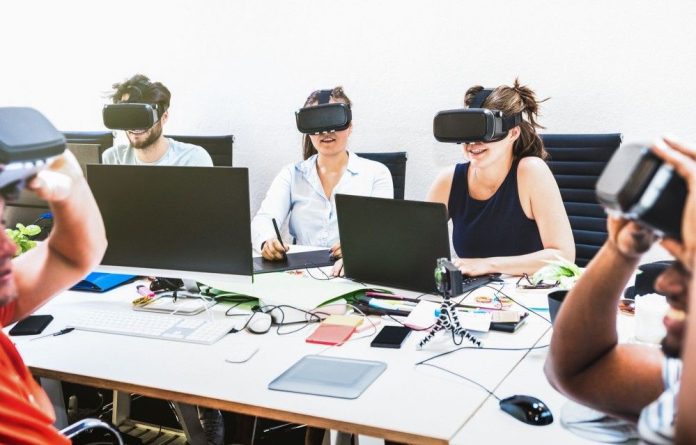The workplace has changed drastically over the past few years. With the rise of virtual reality, companies are now capitalizing on its potential to transform employee training programs. As VR technology quickly evolves, businesses are beginning to recognize the benefits that it can bring to their organization.
One area where this is particularly evident is in employee training programs, where virtual reality is transforming the way employees learn and develop new skills. Companies are embracing VR training for its many benefits, including how virtual reality is transforming employee training programs, leading to cost savings, increased efficiency, and improved employee satisfaction. There seems to be no limit to how far this technology can go in terms of employee development.
Through this article, we will explore how virtual reality is changing the way employees train and develop new skills. We’ll look at the reasons why businesses are embracing VR training and how to get buy-in for it, as well as some key success metrics for piloting and scaling the tech, barriers to adoption, and the effect that it could have on diversity and inclusion initiatives.
Benefits of VR Training
VR training provides a unique learning experience. It recreates real-life settings and simulates work challenges, giving users an immersive, engaging experience. This form of training offers numerous advantages for companies looking to improve employee training and development.
VR technology can help bridge skills gaps, hone skills, and reduce the cost and time associated with traditional in-person training. The initial cost of VR training can be expensive, but savings from reduced downtime and travel can make up for it, and evaluation data shows that VR training has been effective in reducing workplace injuries by 43%, increasing learning effectiveness by 76%, and overall exceeding expectations.
VR training provides learners with an emotionally connected, risk-free environment to experience how their actions play out without real-world consequences. This virtual world allows learners to hone their skills and acquire new ones without fear of failure or costly mistakes. It also allows learners to collaborate with peers, engage with key stakeholders, and develop leadership skills. HR professionals find VR training helpful for onboarding, creating training experiences that can be used over and over again.
Using VR technology, companies can create unique and customized training programs to meet their employees’ needs and quickly fill skills gaps.
Reasons Companies are Adopting VR Training
Companies are getting into VR training for the cost savings, safety, scalability, better retention, ease of use, and more engagement. VR training offers learners a much more immersive experience compared to traditional e-learning. Not only that, but it can also help employees grow their soft skills, like verbal or non-verbal communication, collaboration, and leadership.
It’s key to understand the primary and secondary problems a company is looking to address with VR training, so that training can be tailored to meet those needs and achieve the desired results. VR training can be used to help build an emotionally connected workplace, as well as reducing training time and ensuring that the necessary skills are learned and retained.
It can also increase engagement of both classroom and E-learners, and provide more cost effective training solutions than other programs. Companies can also give their key stakeholders the chance to get involved in the future of the workplace by implementing VR training, without having to worry about the costs of traditional in-person training.
With the right VR equipment and a VR training platform, companies can create a successful training program and roll it out to their employees with ease.
How to Get Buy-in for Virtual Reality Training
Figuring out the problem and its potential effect is the first step in getting people on board with VR training. We need to have the basics on how much it’s costing us and the potential effect in order to convince execs of its worth.
It’s really important to come up with and show stakeholders a clear ROI proposition and implementation plan, as well as get key employees involved to get their support and buy-in for successful adoption. Having a great change management strategy is essential for everyone to successfully get used to new ways of learning, and should be developed to ensure a smooth transition from traditional classroom training to implementing VR training.
HR professionals should consider soft skills as well as technical skills when selecting a VR training tool to bridge skills gaps and retain employees. This should be done in conjunction with an onboarding process that puts the user directly in the experience to increase engagement.
When implementing VR training, it is important to select the right equipment for the job and prove the success of the pilot or initial rollout. This will help ensure a successful rollout and scale of VR for training employees.
Determining if a Virtual Reality Training Pilot is Needed
It’s important to figure out if a VR training pilot is necessary, as it can help cut costs or make VR training better at filling skilled labor gaps. To determine whether or not a VR training pilot is necessary, metrics should be compared to existing training when filling a skilled labor gap, as well as test scores to see if the VR training is as good as or better than the current methods.
A formal pilot is necessary to demonstrate that VR training is successful for a company when they’re looking to cut costs or when a pilot program is necessary for the pilots. Business leaders must weigh the risks and benefits of implementing VR training to their company’s training program. This requires understanding what skills the VR modules should focus on, such as soft skills or safety training.
The data from the pilot program should be collected and analyzed to determine if the VR training works and is cost effective and efficient for the company. By understanding these factors, businesses can make informed decisions about implementing VR training and maximize the potential of VR training for worker safety and skills.
Selecting the Right VR Equipment for Business Applications
Picking the right VR gear for business applications is essential for successful implementation and easy management. From basic headsets that work with your phone to more advanced systems, companies need to take into account hardware needs, screen guards, multiple viewfinders, spatial awareness, and position tracking.
Wireless headsets offer comfort and convenience, which can help increase learner engagement. This is especially important in business applications, as it can help to reduce training time and costs.
When selecting the right VR equipment for business applications, companies should consider factors such as hardware needs, user comfort, viewfinder quality, and position tracking. In addition, they should look at wireless headsets to ensure they are getting the best experience possible. Wireless headsets provide freedom of movement, improved immersion, and increased learner engagement that will help ensure success in VR training programs.
Companies should also evaluate the potential of implementing VR training, as this can be a powerful tool for employee education and development.
Proving Pilot or Initial Rollout Success
Showing pilot or initial rollout success is key to back up the investment in virtual reality training and make sure the training actually helps employee performance. Training scores, time taken to train, and user feedback are often used to gauge a pilot’s success. Collectively, these metrics provide an effective measure of the pilot’s performance.
We can measure training scores by comparing pre- and post-training assessments. We can measure time taken to train by recording how long it takes for employees to finish the training. And we can measure user feedback through surveys or interviews asking about how effective the training was.
Suggested questions for user feedback surveys include inquiries such as “How confident do you feel with the new skills you learned?” and “On a scale of 1 to 5, how helpful was the virtual reality training?”
Rolling Out and Scaling Virtual Reality for Training Employees
To get virtual reality training up and running for employees, a company must figure out the goals for the program, create content, select a spot for the training, and sort out the logistics. This rollout also requires ongoing effort and adaptability.
Once the program is in motion, organizations should focus on expanding the training and promoting it regularly in employee communications. It is also crucial to keep track of progress in VR training to ensure the program is reaching its objectives and enhancing where necessary. By doing this, companies can determine which content and groups have the biggest effect on the issue.
Examples of VR in the Workplace
Virtual Reality is quickly becoming a staple of the modern workplace. Companies and organizations across the globe are turning to Virtual Reality (VR) to supplement their training and development initiatives, particularly for soft skills training.
From H&R Block, which used VR simulations for customer service training to emphasize interpersonal skills such as active listening, to Ford, which has been using VR to make car models, businesses have found that VR has a huge range of applications.
VR training can also be used to reduce risk in high-stakes situations, giving people the opportunity to practice in a safe environment and get used to the equipment and the area before they actually go there. This is especially beneficial for the military, which uses VR to simulate unpredictable and complex scenarios so that soldiers can be better equipped to handle all sorts of combat situations.
Barriers of VR Training Adoption
The cost of lack of tech access, doubts about how effective it is compared to traditional methods, compatibility issues, limited users, and it being hard to tell what’s real and what’s not are all issues with using virtual reality training.
Companies looking to implement VR training often face a significant barrier in the form of the high initial cost of the VR gear and software. It can be tricky integrating VR training with existing learning management systems, given compatibility issues and the need for extra tech support.
Potential employee resistance to VR training could come from worries that the tech is too complicated or hard to use, feeling uncomfortable or getting motion sickness from VR, or just preferring old-school training methods.
Summary
There’s no denying the potential of virtual reality to revolutionize the modern workplace. In 2023, we are already seeing signs of this trend in the growing use of VR in employee training programs. Companies that invest in virtual reality training benefit from cost savings, safety, scalability, better retention, ease of use, and increased engagement.
However, it’s not without its challenges: implementing VR training can come with high initial costs, compatibility issues, a limited user base, and a lack of understanding of what is real or not. Thus, companies need to do their homework before embarking on a successful virtual-reality initiative. They must deliver a clear ROI proposition, assess their progress in pilot projects, select the right VR tool for the job, and create effective change management strategies.
If done right, virtual reality training has the power to reinvigorate employee skills and transform worker interactions into something truly special.
Frequently Asked Questions
What is the benefit of virtual reality for employee training?
Virtual reality has many benefits for employee training and development, including creating a safe and controlled environment, cost-effectiveness, increased engagement and retention, scalability, and flexibility.
VR training offers a unique and engaging learning experience that can provide employees with increased confidence and help reduce costs.
How is virtual reality explored for corporate training?
Virtual Reality is increasingly becoming an attractive tool for corporate training. By creating immersive digital environments, companies can simulate a diverse range of workplace scenes, enabling trainees to gain real-world experience without putting themselves or others at risk. It’s revolutionizing the way companies conduct effective training programs.
VR technology is enabling companies to explore new ways of conducting corporate training. By taking advantage of the immersive environment it provides, it allows staff to experiment and gain confidence in their industry knowledge in a safe virtual space. This more personalized approach is paving the way for a more successful learning experience.Nov 8, 2022.




































